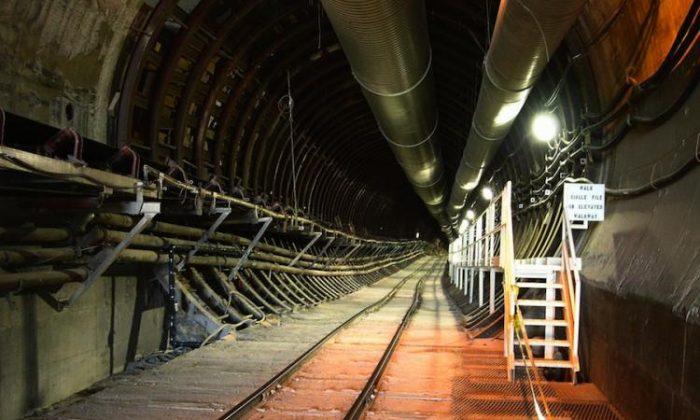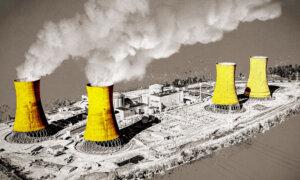The first commercial electricity-generating nuclear power plant in the United States was in operation by 1957 in Shippingport, Pennsylvania. But 66 years later, the United States still doesn’t have a permanent facility to store the highly radioactive spent fuel that this and other nuclear power plants produce, leaving stored waste dotted across the country and costing taxpayers billions of dollars.
In November 2023, the Nuclear Regulatory Commission (NRC) released most of the land where the Zion Nuclear Power Station in Zion, Illinois, once stood. The power plant operated two pressurized-water nuclear reactors from 1973 to 1997. Zion was shut down in 1998 and underwent a decommissioning process, and now the NRC says most of the land at the former plant site may be used for any application.
But the plant’s spent fuel storage facility, covering about five acres, will remain under NRC oversight with a spent fuel storage facility license held by Constellation Energy Generation, which will be responsible for the security and protection of Zion’s spent fuel facility until an offsite storage facility or permanent disposal site becomes available.
That could be a long time.
Although it’s supposed to have a storage facility operating by now, the U.S. government doesn’t have a long-term plan to store the highly radioactive waste produced by nuclear power plants.
The 1982 Nuclear Waste Policy Act defined a timetable of milestones for three federal agencies to meet to control highly radioactive waste.
It gave the Department of Energy (DOE) the responsibility to find a site and build and operate a deep geologic repository for the disposal of the waste, told the Environmental Protection Agency (EPA) to develop standards for the protection of the environment from offsite releases of radioactive material in repositories, and made the NRC responsible for licensing the DOE to operate the repository, only if it meets EPA’s standards.
The DOE was meant to have a facility constructed and accepting waste by January 1998. But 26 years after that deadline, there’s no movement to make that happen. The DOE didn’t respond to requests for comment, but there are many documents explaining its current strategy, which is to keep spent fuel where it is and engage in a long, complicated planning process it has developed—consent-based siting—that more fully involves public opinion.
Billions Paid in Damages
Like Zion, nuclear power plants across the United States are leaving spent fuel stranded at reactor sites while they wait for a permanent storage facility. This is an expense not factored into the planning stages when the plants were built.Temporary Storage
Since that report, two facilities have moved forward.“We have issued licenses within the past two years to two companies who applied to do CIS facilities,” David McIntyre, public information officer at the Nuclear Regulatory Commission, told The Epoch Times. “Their plan was to each take some of the fuel from the plants, starting with the ones that are shut down and take it to their facilities and store them in dry cask until a disposal facility option becomes available.”
These temporary CIS licenses belong to Interim Storage Partners in Andrews County, Texas, which started the licensing process in 2016 and was granted a license from the NRC in 2021, and Holtec International in Lea County, New Mexico, which started the licensing process in 2017 and was granted a license in May 2023.
But both projects have been stalled by political pushback.
A U.S. appeals court canceled the Interim Storage Partners license in August 2023, saying the NRC lacked the authority under federal law to issue permits for private, temporary nuclear waste storage sites.
In New Mexico, a recently passed law sponsored by state Sen. Jeff Steinborn, a Democrat, attempts to block the project by requiring a federal, permanent repository to be in operation before nuclear waste can be stored in New Mexico. The NRC issued a permit despite this state law.
Sen. Martin Heinrich (D-N.M.), who serves on the Senate Energy and Natural Resources Committee, is also working against the interim strategy.
Yucca Mountain
Deep in the Nevada desert, the people of Nye County have, for decades, been hearing about the proposal to store high-level radioactive waste in Yucca Mountain. Public hearings started in 1983.In 1994, workers started to bore a tunnel into the mountain, and some infrastructure for a storage facility was built in the following years. In 2008, the DOE submitted a license application to the NRC to build a permanent repository tunnel deep in the rock, where carefully packaged radioactive materials would be stored.
President Barack Obama killed the Yucca Mountain project in 2009, including nothing in the 2010 budget to dispose of waste from nuclear power plants.
In 2017, President Donald Trump’s administration called for a restart of licensing for Yucca Mountain. Then-Nevada Gov. Brian Sandoval swore he would oppose any attempt to continue the development at Yucca Mountain.
“The county felt it could be done safely,” Darrell Lacy, former director of Nye County Nuclear Waste Repository Project Office, told The Epoch Times. “The county was open to economic development in a rural county that didn’t have a lot of other options.”
The project promised 3,000 jobs.
“If you look at other nuclear facilities around us in the world, the local communities are supportive because they recognize the economic development and the tax revenues,“ Mr. Lacy said. ”And they’re more familiar with the projects and are not as susceptible to fear-mongering because they either work there or have friends that work there.”
After spending billions of dollars on the project, it’s unclear whether the Yucca Mountain facility will ever be revived.
“If you talk to people within the Department of Energy and in Congress, they say it’s dead. But there’s not a consensus on what the next step is going to be until Congress passes some new legislation,” he said.
Any new permanent repository would take 60 to 100 years to start accepting waste, according to Mr. Lacy. Any site would have to go through the scientific evaluation process, permit approvals, the public siting process, and the construction process.
“So it is not only, ‘How do you get consent today?’ It is, ‘How do you keep consent through all this whole process?’” he said, noting that as political leaders change, the status of the project changes with them.
In the late 1970s, Nevada politicians invited the federal government to consider Nevada for a storage facility. Today, many political leaders are against it.
“People in the local community are very supportive because we’ve had the Nevada Test Site—the weapons testing programs—going on through the ’60s, ’70s, and ’80s,” Mr. Lacy said.
Those tests stopped in 1993, but before that, the tests were sometimes a form of entertainment for the locals.
“People used to line up on Mount Charleston, which is a mountain overlooking the Nevada Test Site. A beautiful, flat location up 8,000 feet, and there’s waiting areas and turnouts on the roads, where people would park and watch the announced above-ground nuclear tests,” Michael DeLee, an Amargosa attorney and real estate broker, told The Epoch Times.
Amargosa is the nearest town to the Yucca Mountain site, about 18 miles away.
In 2022, the DOE said that since 1999, it had made more than 32,000 radioactive materials shipments from a former dump at the Idaho National Laboratory to the Nevada Test Site, now called the Nevada National Security Site. Yucca Mountain is adjacent to the Nevada Test Site.
The federal government’s defense program, starting with the Manhattan Project, produced a very large amount of nuclear waste, according to Mr. Lacy. Spent fuel left over from commercial power production accounts for about 80 percent of the waste that would be placed in Yucca Mountain.
The DOE has a significant amount of waste, some going back to the 1940s and the Manhattan Project, and it’s currently trying to clean it up. This waste is more varied in type, form, and radioactivity levels.
“We are spending several billion dollars a year for this cleanup program, and it is progressing slowly,” Mr. Lacy said. “But it is another piece of the puzzle that needs a solution.”
How Waste Is Made
The fuel in nuclear reactors is enriched uranium made into ceramic-like pellets, which are placed into metal rods made of zirconium alloys that can withstand high heat. The rods are grouped together to make fuel assemblies. Nuclear fuel is usually used in the reactor for three to six years. About once every 12 to 24 months, one-third of the fuel in a reactor is unloaded and replaced with fresh fuel, according to the U.S. Energy Information Administration (EIA).After use in the reactor, fuel assemblies are highly radioactive and must be submerged in a pool of water for several years at the reactor site. The spent fuel continues to give off heat from the decay of the radioactive elements that were created when the uranium atoms were split during fission. Water in the spent fuel pool cools the fuel and blocks the release of radiation.
In a few years, the spent fuel cools in the pool and may be moved to a dry cask storage container that’s stored at the power plant in “interim” storage.
The last step would be to collect spent fuel assemblies from the interim storage sites and move them to a permanent underground repository.
The United States currently has no permanent underground repository for high-level nuclear waste, according to the EIA.
From 1968 through Dec. 31, 2017, a total of 276,879 fuel assemblies were discharged and stored at the sites of 119 closed and operating commercial nuclear reactors in the United States, according to the EIA.
More than 86,000 metric tons of spent nuclear fuel was stored onsite at 75 operating or shut-down commercial nuclear power plants in 33 states by the end of 2019, the Government Accountability Office report states, with an estimated 2,000 metric tons of spent fuel expected to accumulate annually.
“We have enough waste right now to fill up Yucca Mountain if Yucca Mountain were open,” Mr. Lacy said. “We should be building Yucca Mountain and working on the next site.”
The EPA had limited Yucca Mountain to holding 70,000 metric tons of spent nuclear fuel and high-level waste unless a second repository opens during its operational lifetime.







